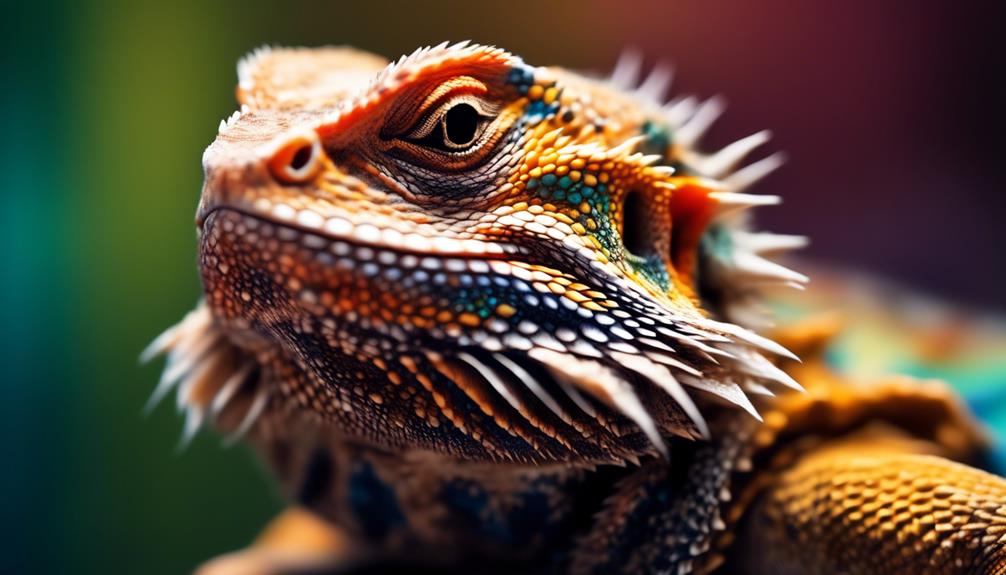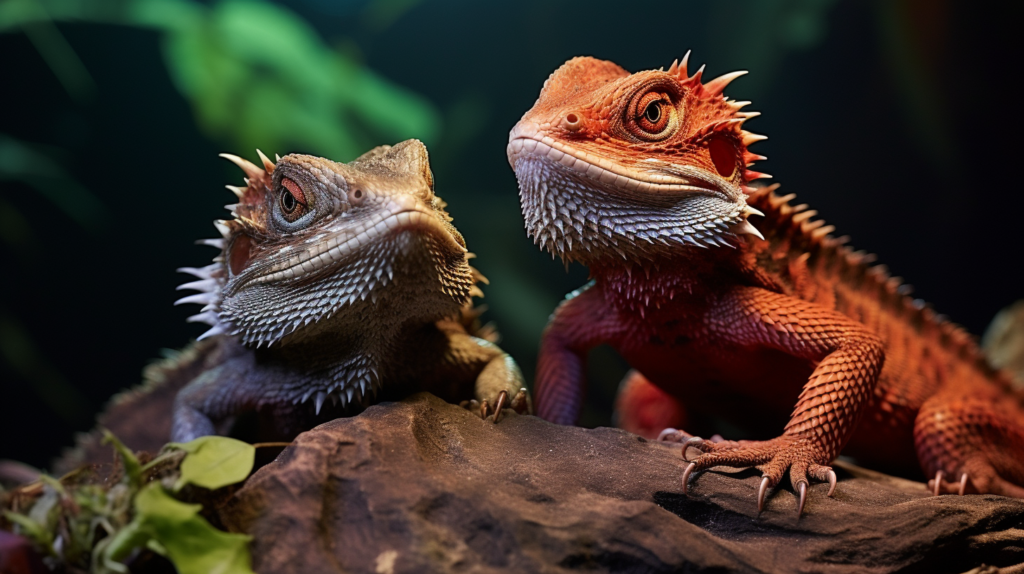You’ve likely observed your bearded dragon puffing its beard, but have you noticed that it’s not turning black? This behavior can be both intriguing and concerning for reptile owners.
Understanding the reasons behind this behavior is crucial for ensuring the well-being of your pet. There are various factors that could contribute to this puzzling phenomenon, from environmental triggers to potential health implications.
Exploring the intricacies of bearded dragon behavior and the underlying causes of beard puffing can provide valuable insights into caring for these captivating reptiles.
Bearded dragons puff their beards to communicate dominance or ward off threats. The color change in beard puffing is due to hormonal influences and genetic factors, triggered by environmental stimuli such as stress or mating rituals.
Normal Behavior for Bearded Dragons
What are the normal behaviors exhibited by bearded dragons?
Bearded dragons display various body language cues to communicate their feelings and intentions. When feeling threatened or aggressive, they may puff out their beard, darken their throat area, and open their mouth to appear larger and more intimidating. This behavior is their way of establishing dominance or warding off potential threats.
In captivity, bearded dragons exhibit social interactions through body language. They may wave their arms, bob their heads, or perform push-up displays to communicate with other dragons or their human caretakers. These actions can signal submission, courtship, or territoriality. Understanding these behaviors is crucial for providing a suitable environment and addressing their social needs.
Observing and interpreting a bearded dragon’s body language is essential for their well-being in captivity. By recognizing their signals, you can create a comfortable and enriching environment that supports their natural social behaviors. This understanding also fosters a deeper connection with these fascinating reptiles, allowing you to respond appropriately to their social cues and enrich their lives in captivity.
Potential Reasons for Beard Puffing
When a bearded dragon puffs out its beard, it’s often a response to feeling threatened or aggressive, using this behavior to establish dominance or deter potential threats. Social interaction plays a crucial role in triggering beard puffing. Bearded dragons are territorial by nature, and when they perceive a threat or feel challenged, they may inflate their beard to appear larger and more intimidating. This behavior is a part of their stress response mechanism, allowing them to communicate their discomfort or unease in social situations.
Understanding the potential reasons for beard puffing also involves recognizing the significance of dominance within the social hierarchy of bearded dragons. In a group setting, beard puffing can be a way for these reptiles to assert dominance over others, especially during interactions related to mating, feeding, or territory.
Additionally, environmental stressors such as sudden changes in habitat or the presence of unfamiliar stimuli can also lead to beard puffing as a coping mechanism.
Behavioral and Environmental Factors
The display of beard puffing in bearded dragons is influenced by a variety of behavioral and environmental factors, reflecting their responses to social interactions and external stressors.
Environmental stimuli play a significant role in triggering beard puffing behavior. Factors such as sudden loud noises, presence of predators, or even changes in temperature can lead to beard puffing as a defensive response.
Social interactions also play a crucial role in influencing this behavior. Dominance displays, territorial disputes, or courtship rituals can all lead to beard puffing in bearded dragons.
Understanding the environmental and social triggers for beard puffing is essential for creating a suitable habitat for these reptiles. Providing hiding spots, minimizing sources of loud noises, and ensuring stable temperature gradients within their enclosure can help reduce environmental stressors that might provoke beard puffing.
Additionally, carefully managing social interactions by providing adequate space and visual barriers between dragons can help minimize aggressive displays that lead to beard puffing.
Health Implications and Monitoring
To monitor the health implications of beard puffing in bearded dragons, regularly observe their behavior and physical condition for any signs of distress or illness. Keep an eye on their appetite, energy levels, and overall demeanor. A sudden change in these factors could indicate a health issue. Additionally, pay attention to their skin and eyes for any abnormalities such as discoloration, discharge, or swelling. It’s important to note the frequency and duration of beard puffing episodes, as excessive or prolonged puffing may signal an underlying health concern.
In terms of health monitoring, consider making dietary adjustments if necessary. Ensure that your bearded dragon’s diet is nutritionally balanced and appropriate for their age and size. Offer a variety of gut-loaded insects, leafy greens, and occasional fruits. Proper hydration is also crucial, so provide access to fresh water and consider occasional gentle misting to support hydration.
Regular veterinary check-ups are essential for monitoring your bearded dragon’s overall health. A reptile-savvy veterinarian can provide guidance on health monitoring and dietary adjustments specific to your pet’s needs. By staying vigilant and proactive in health monitoring, you can help ensure the well-being of your bearded dragon.
Handling Puffed Beards in Bearded Dragons
For proper care of your bearded dragon, it’s important to understand how to handle their puffed beards, as it can be indicative of their stress or discomfort.
When your bearded dragon puffs its beard, it’s essential to approach them calmly and avoid sudden movements. Pick them up gently and support their body to provide a sense of security.
If the puffing is due to stress, it’s important to identify and address the underlying cause. Stress in bearded dragons can be triggered by factors such as inadequate enclosure size, improper temperatures, or lack of hiding spots.
Ensuring the enclosure is spacious, maintaining appropriate temperatures, and providing hiding spots can alleviate stress.
Additionally, beard shedding is a natural process for bearded dragons, and during this time, they may exhibit increased sensitivity in their beard area. Handling should be minimized during beard shedding to prevent any discomfort.
Regularly inspecting the beard for signs of stuck shed and providing appropriate humidity levels can aid in a smooth shedding process.
Frequently Asked Questions
Can Bearded Dragons Change the Color of Their Beard Puffing, and if So, What Causes the Change?
Bearded dragons can change the color of their beard puffing due to hormonal influences and genetic factors. This behavior is a response to environmental stimuli, such as stress or mating rituals. Hormonal changes trigger the color shift in the beard.
Do Bearded Dragons Puff Their Beards as a Form of Communication With Other Bearded Dragons?
When bearded dragons puff their beards, it’s often a part of their social interactions. This beard puffing behavior can serve as a form of communication with other bearded dragons, conveying various messages and signaling different intentions.
Are There Any Specific Environmental Factors That Can Trigger Beard Puffing in Bearded Dragons?
Specific environmental triggers, such as stress, territorial disputes, or mating behavior, can prompt beard puffing in bearded dragons. Understanding these behavioral responses can help you create a suitable environment for your pet.
Can Frequent Beard Puffing in Bearded Dragons Indicate a Potential Health Issue?
Frequent beard puffing in bearded dragons can be a sign of potential health issues. Common causes include stress, illness, or discomfort. These behavioral cues may indicate environmental influences or health implications, warranting a thorough evaluation.
Is There a Recommended Approach for Handling a Bearded Dragon With a Puffed Beard to Minimize Stress and Potential Aggression?
When handling a bearded dragon with a puffed beard, observe its body language and stress indicators. Use gentle handling techniques to minimize stress and potential aggression. Recognizing behavioral cues is crucial for serving their needs effectively.
Conclusion
In conclusion, understanding the normal behavior, potential reasons for beard puffing, and the behavioral, environmental, and health implications is crucial in handling puffed beards in bearded dragons.
By monitoring their behavior and environment, you can ensure the well-being of your bearded dragon.
Keep in mind the importance of addressing any potential health issues promptly and seeking advice from a veterinarian if necessary.
Remember, proper care and attention are essential for the health and happiness of your bearded dragon.


